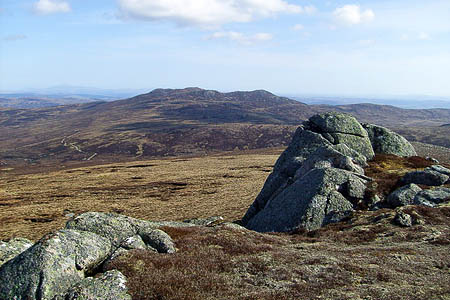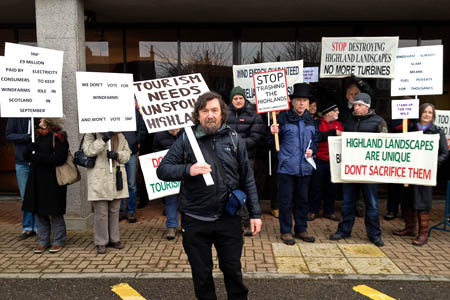The Scottish Government has turned down controversial plans for a major windfarm on the hills above Bonar Bridge in the Highlands.
Energy minister Fergus Ewing said the 34 proposed Glenmorie turbines would have an unacceptable impact on the landscape, including wild land.
Mountaineers and campaigners who opposed the plans welcomed the minister’s decision.
The Mountaineering Council of Scotland, which joined the John Muir Trust and local councils in fighting the proposals, said it was hoping for a similar decision on the Allt Duine proposal in the Monadhliath Mountains.
Chief officer David Gibson said: “We are very relieved that the right decision has been made on a deeply wrong-headed scheme.
“We objected to the development and participated in the public local inquiry due to its highly intrusive visual impact on some of Scotland’s finest mountains and wild land.
“I would like to thank the Scottish Mountaineering Trust, [British Mountaineering Council] and our members who supported our efforts to oppose the development.
“Like many other objectors, we are hoping for a similar decision on the Allt Duine windfarm proposal which, if approved, would be a major industrial development on wild land and adjacent to the Cairngorms national park.
“The Allt Duine PLI took place about nine months prior to that for Glenmorie, so we think a decision by John Swinney MSP must be imminent.”
The MCofS said it does not oppose onshore windfarms and has only objected to around one in 20 proposals. It fights schemes where they threaten our rapidly diminishing areas of wild land and would harm Scotland’s mountain landscapes, it added.
Helen McDade, head of policy at the John Muir Trust, said: “We are delighted that this development has been refused.
“It was a wholly inappropriate site, which would have impacted on an area recently confirmed as a wild land area. This was an unsuitable development that should never have been brought forward in the first place.
“It would have destroyed an area of wild land, had a damaging effect on peat land and could have had harmful long-term economic consequences for the area.
“Councillors from all political parties came together to object to this giant development. There was also strong opposition from the local community. It would have been a travesty of democracy if this development had been given the green light.
“The refusal today by the Scottish Government sends a strong message to developers that it is inappropriate to target areas now recognised in Scottish planning policy as nationally important for their wild land qualities.
“And it is a welcome indication that the Scottish Government is delivering on its commitment in the new national planning framework to continue its strong protection for our wildest landscapes. This is a victory for those who want to see Scotland’s wild land protected against large-scale industrial development.
“We are therefore delighted that the Scottish Government has rejected it.”
The view was echoed by the Save the Monadhliath Mountain group, which is fighting the Allt Duine proposals for a windfarm near the edge of the Cairngorms national park.
Former president of the Mountaineering Council of Scotland and spokesperson for the SMM campaign, Chris Townsend, said: “I am delighted that the Scottish Government has rejected this application which would have devastated a landscape designated as an area of protected wild land.
“Ministers have indicated their willingness to protect our wild landscapes and now need to show consistency by rejecting the Allt Duine application, which would be sited close to the Cairngorms national park boundary and within wild land.”
The MCofS said the Glenmorie turbines would have been built on the slopes of Carn an Lochan, Clach nam Ban and Carn Cas nan Gabhar and the windfarm would have come within 150m of the eastern boundary of a large area identified by Scottish Natural Heritage as a search area for wild land.
The John Muir Trust pointed out the development would have been visible from the designated national scenic area around the Dornoch Firth, and from the slopes of the munro Ben Wyvis, a special landscape area.



Alan
22 August 2014The Scottish government are wanting Scotland to be self sufficient from electricity by the early 2020's. Without wind power this seems unlikely. What would their decision be, say after a yes vote ?
David
22 August 2014Some will no doubt object, but why can we not exploit a much more reliable renewable source? Tidal power. It's vastly more reliable than wind, and the turbines are unseen and unheard. MayGen has recently been given approval to build a tidal turbine array in the Pentland Firth. I think that's considerably less objectionable than destroying vast swathes of high land with windfarms.
Ian
22 August 2014Agree with you both.
JB
22 August 2014Wind power is not a reliable method of energy production in that generation depends on the wind. Sometimes periods of peak demand coincide with low or nil wind (e.g. the prolonged extreme cold spell in Dec. 2010 which coincided with the Christmas period and during which there was minimal wind). For this reason a country always needs enough "base load capacity" (conventional power generation which can produce power on demand regardless of currently available wind, sun etc) to meet 100% of demand in order that the lights can all be kept on when the wind isn't blowing.
So every single watt of windpower generation infrastructure you build needs to be backed by conventional generation capacity elsewhere (coal, gas, nuclear) which can step in when needed. Wind still has its place and can reduce fossil fuel usage at least some of the time, but this fundamental limitation will always remain. Therefore there should not be such a huge emphasis on wind power with so much subsidy spent on it whilst other promising power generation methods are largely ignored.
GeorgeH
23 August 2014The Tasmanian Wedge-tailed Eagle is at the point of extinction due to wind farms. Recent research from around the world indicates horrific bird mortality rates:-
Spain - 330 Birds per turbine per year
Germany - 309 Birds per turbine per year
Sweden - 895 Birds per turbine per year
When will the wind industry tell us the Scottish figures?
James Corrigan
23 August 2014Wind energy. The great unreliables should be abandoned on the grounds of absolute stupidity. It is simply a modern day gold rush by uncaring developers. Often absent landowners with addresses no where near what they want to destroy. Worse still is landowners, who only care about profit and not what they trash to get that profit.
Jimbob
26 August 2014Build nuclear instead, I am sure people would love to live next to that.